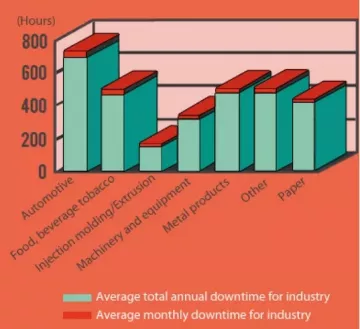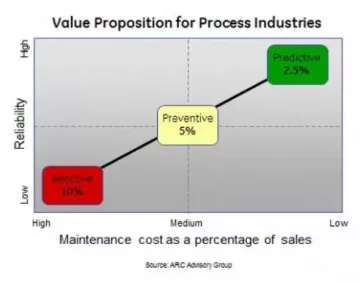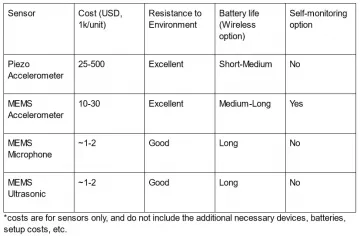Preventive and Predictive Maintenance: Which Asset Management Strategy Has the Best ROI for You?
Some terminology of the past, both in the government and private sector would explain maintenance as the process of equipment repair after it is broken, however, some, a bit more modern definition implies maintenance as the action of upkeep, dedicated to handling the proper long-term condition of equipment, process or a part.
Maintenance strategy can be generally divided into Reactive, Preventive, and Predictive maintenance.
To lead effective asset management, one cannot rely on reactive maintenance alone, as it increases the downtime and forces to bring crisis management solutions – often not calculated for long-term success, but for the least short-term loss.
Preventive and predictive maintenance strategies are known as the more proactive approaches in asset management strategy, they aim to increase reliability and decrease the potential of failures and sudden downtimes.
There are a few key differences between preventive and predictive maintenance strategies that a decision maker ought to consider, for better performance, and accurate return on their investments .
Difference between Preventive and Predictive Maintenance
Preventive maintenance is a scheduled maintenance strategy, to take place in pre-determined conditions and periods of time.
Predictive maintenance is scheduled on an as-needed basis, depending on the condition of the asset (this condition is defined by e.g., measurement systems).
A manager putting together the preventive maintenance asset management strategy needs access to industry averages for the specific equipment, be aware of OEM special requirements and overall keep the finger on the pulse to not be late in maintenance reactions.
At the same time, a manager of a predictive maintenance strategy can have more reliable in-house data, which can be utilized depending on the current state of the specific equipment, by calculating potential maintenance needs that will come up. Let’s try to define the two specifically.
What is Preventive Maintenance?
An asset or process management strategy for cyclical upkeep and maintenance activities, to ensure long-term proper operation.
The regulated technical tests and checks carried out by the internal maintenance responsible for the team, the need to replace, clean, fix some parts and pieces of the asset, and make adjustments becomes clear and helps prevent failures that could otherwise occur.
There are Computerized Maintenance Management System (CMMS) modern systems that can help maintenance managers to organize maintenance checks for a certain period of time (weekly, quarterly, yearly, etc.) and assign the appropriate tasks for maintenance technicians beforehand, ensuring the proper qualification by the time it is necessary.
Once the asset of maintenance is chosen and outlined, the maintenance manager can schedule and prepare for the strategy of Structural Health Monitoring and Process Integrity Monitoring.
With the possibility of CMMS software, the maintenance manager can proceed with:
- Set a Pre-determined maintenance cycle with the currently available information.
- Data acquisition.
- Maintenance task outline and schedule.
- Technician qualification outline and assignment.
- Results Monitoring after the maintenance cycle is complete.
- Adjustment of Maintenance Strategy based on results of the previous cycle.
What is Predictive Maintenance?
The asset maintenance strategy, relies on condition-based decisions, is often automated through sensors and software that track the ongoing performance of an asset, and predict possible failures within a certain time period.
The objective of investment in a predictive maintenance system is to detect a potential malfunction and avoid it as early as possible. This, not only helps save resources that would be lost in a potential downtime but also, helps avoid the unnecessary maintenance cycles that are common in a preventive maintenance strategy.
How to Implement a Predictive Maintenance Program
The initial investment and implementation procedures of a Predictive Maintenance strategy are often more complex than that of the preventive one, as it indicates the utilization of IoT sensors and software which will continuously (or cyclically, depending on the application) track the performance of the asset.
CMMS software can be set up to send alerts and notifications to the maintenance team and the relevant technicians, showing the data, and even the specific task required to avoid potential failures. These systems can help the process tremendously while saving on unnecessary waste of Human Resources’ time, maintenance process downtimes, replacement of broken parts, and unnecessary overuse of tooling and equipment for maintenance actions.
Average ROI from Predictive Maintenance
The Maintenance activities’ worth to invest in, are largely motivated by the amount of resources a faulty, or broken asset brings. Even the assets which are expected to be broken, and relevant maintenance is set for them, come with a fair share of sudden additional faults, pushing the asset manager to react, and put down fires (sometimes literally), in the quickest ways possible, which are often the costliest and still, rather time-consuming.

The US department of energy reported some important insights on the average cost savings from predictive maintenance. One of these insights is the 10× return on investment projection. Surely the specific numbers and thresholds will have to depend on the industry, and size of the asset/operation/plant, however, the average numerical representation is rather exciting.
Survey results indicate a few important savings as a result of predictive maintenance activities implemented in plants and processes by asset managers:
- 70 – 75 % breakdown reduction;
- 35 – 45 % reduced downtime;
- 25 – 30 % less maintenance;
- 20 – 25 % production increase.

These impressive results are the motivation for the increasing investments made in Predictive Maintenance applications and the overall market growth. The predictive maintenance market will grow at a 31% CAGR reaching up to 28.2 billion USD by 2026 compared to the 6.9 billion USD of 2021.
The business behind Predictive Maintenance
It is of course clear that the Return on such complex investments as the Predictive Maintenance Application – is essential to calculate and plan. At the same time, to be more confident in decision-making, it is important to take into account the industrial organization, which often needs the ROI calculation of the Predictive maintenance. This means that contrary to e.g., ROI calculation of business services, here it is also essential to know the overall costs included in owning the asset.
Thus, an interesting and important step in calculating the ROI from the Predictive Maintenance(as well as preventive maintenance) strategy, to take it to the next level, is the utilization of the Total Cost of Ownership (TCO).
This calculation largely depends on the expected difference in the current and future earnings and savings that the considered investment aims to affect. In this context the factors of time (how expensive is the potential downtime, and preventive maintenance time losses) as well as the unit factor (is it a single asset management or bulk of them, if it is a bulk of assets are they similar assets or different types of the same asset).
Here it is also important to understand the ability of a small to medium size factory to have an in-house maintenance team. Eventually, it is not an inexpensive service, especially if preventive and reactive maintenance are the chosen strategies – the availability of a maintenance team and the size of the team becomes rather crucial to keep the operation smooth and tooling up to date.
A logical step here, to save some resources, is to hire routine technicians for maintenance services and leave the complex repair and maintenance tasks to the sector professionals. An additional point here is for or against outsourcing the Original Equipment Manufacturer for the repair or going with a Third Party Maintenance service provider (which also has expertise in the sector).
Outsourcing OEM for Maintenance and Repairs:
To make the case for the OEM here is not too hard – sometimes the maintenance practice comes with the equipment that the manufacturer provides, it is often part of the deal for a certain period of time. This is the service program to guarantee the proper operation and investment decision. Later, getting maintenance service from many OEMs is also discounted, as a part of their customer loyalty programs.
Another point for the OEM here is the guarantee that the OEM will use the appropriate, original parts and tools dedicated to the equipment, which come with additional warranties for the repair or maintenance task – so there is no need here to research and find the proper, most cost-effective options, as you already get the best possible detail/addition/cleaning/tooling for the specific application aligned with the warranty standards.
However to get the standards in place, often the OEMs are reluctant to flexible changes and additions to the application, as there is a catalog of services and parts that the buyer agreed to, prices for which are carefully calculated with OEM’s risk. However, these prices may increase as the details and parts (exclusive to the application provided by the OEM) become antiques and deficit.
These services may also be the more expensive option in the market, as risk mitigation is included in the price.
Outsourcing TPM for Maintenance and Repairs:
This is an, even more, cost-effective option for maintenance as the third-party provides the service outside the original manufacturer so there is more flexibility and less restrictions to the provided service.
Usually a TPM provider can be called on as-needed basis, with lawyer costs than an OEM, it comes with consultations on the options of repair and maintenance, and it comes with competition thus the service and price can be adjusted to the exact need of the plant/factory. Often aftermarket parts are enough to cover the issue for the necessary time, thus also a good way to save some costs and tailor the service to the in-house assembly of assets.
Here the main drawback is that a TPM provider hardly ever matches the standards that an OEM operates with. An OEM also has a tailored approach to the specific equipment and deep familiarity with the repair and maintenance practices needed for their asset, whereas a TPM provider is usually driven by general industry standards.
Business Case of an Individual Asset: Costs for Predictive Maintenance
The costs involved in setting up a predictive maintenance strategy can be divided into initial (single payment) and recurring costs.
The initial costs are the single payment for setup or development of the monitoring technology, machine costs, training of technicians, software development, and data acquisition costs.
Recurring costs are the ones that, in the case of predictive maintenance, come up much less often than in the case of preventive ones, and are dedicated to energy payments, Maintenance Strategy managers, etc.
Mueller Industries Moving from Preventive to Predictive Maintenance
The famous metal manufacturer Muller Industries had a traditional asset management approach with their preventive maintenance strategies in the context of equipment maintenance especially. Seeing the tech development in the industry, Mueller decided to not miss on the opportunity to save, and as they are famous for the calculated R&D risks they take, condition monitoring and predictive maintenance strategy was set forward.
The initial system had the form of a handheld contact microphone sensor which was connected to an application on a smartphone, making it a remote vibration detection device. It was a simple yet elegant system that allowed technicians to gather data from an increased distance. This data then was processed through machine learning and indicated any potential failures in place.
With this issues like wear & tear on a rapid bearing from the high-speed machines were detected much more promptly – information that Muller didn’t have before and could now utilize for faster repair.
PepsiCo Vibration Readings for Downtime Reduction
At the Drito-Lay plant more than 150 million pounds of products are manufactured (snack foods). After 50 critical assets were chosen for remote vibration monitoring, and Third Party analytics company processed the data, the plant managed to get the equipment downtime to 0.75 %, and the unplanned downtime as low as 2.88 %.
The vibration readings helped to prevent a combustion motor from shutting down. After these 2021 maintenance activities, now quarterly in-house and outsourced maintenance checks are conducted on all motor control rooms, and vibration / infrared monitoring on selected equipment.
Bentley Systems and SMRT Trains ltd.
Based on the Bentley Systems Predictive Decision Support System (PDSS), the Singaporean SMRT Trains managed to:
- Avoid ~ 20 maintenance train deployments.
- Avoid 100s of hours on manual planning.
- Achieve as long as 1000× travel across the network before service was necessary.
Previously manual maintenance planning methods were used, utilizing millions of data points, with 282 km of rail track (around 2 million humans daily riding the train in 2020) – the manual processing of the data was inefficient. What SMRT Trains implemented with the Predictive Decision Support System was to centralize the data and planning the maintenance was automated based on AssetWise linear analysis.
Daimler Chrysler Predictive Maintenance savings in Ohio plant
For an Ohio plant Chrysler was set to acquire over 600 machines: the quality and condition control was of course a priority.
Utilizing vibration and infrared sensors during the purchase of a machine, and then using the data throughout the lifetime with predictive maintenance software was the essential plan. Eventually, it was reported that Chrysler was able to identify issues with over 100 of their machines and ended up saving the plant up to 112.000 USD in repair costs by application of predictive maintenance.
This doesn’t include the saved downtime during the lifetime of operating the machines in question.
Examples like this, especially by 2023 are hardly an early invention, but rather a part of the trend that industry professionals are clearly aware of, and prioritize even more in their R&D and Maintenance budgets.
Let’s see what other sensors are used for predictive maintenance.
Predictive Sensors
An investment in a Predictive Maintenance solution is already a substantial step for a company or a plant, thus making sure the sensors “are not on the way” is a large added value when considering which ones to choose. This means that if a measurement system includes many sensors, large, and bulky, which often break, which are expensive and require maintenance checks themselves, which have bugs in software – the asset manager and financial decision maker for the maintenance strategy will likely take vast losses.
Thus a wireless sensor, tiny and effective, precise in measurements, and easy for the technicians to work with – will be the first practical step towards predictive maintenance application.
These sensors should also be rather precise as they are meant to detect anomalies and help predict failures much earlier than those will have taken place. After an initial large investment, high power consumption does not make sense either, thus an elegant, simple and fairly inexpensive system is the one to choose.
However, before choosing the sensor, we need to know what to measure exactly, and what are the available options for those measurements.
Let’s consider a few of these available systems for Condition Based Monitoring :
For Vibration Measurements:
- Piezo accelerometers
- Covers frequencies of up to 30 kHz;
- Misalignment detection;
- Load condition;
- Cavitation;
- etc.
- MEMS accelerometers
- Relatively low cost;
- Relatively miniature;
- Lower power consumption;
- Covers frequencies of up to 20 kHz;
- Load condition;
- Wear and tear (i.e. bearing condition);
- etc.
For Temperature Measurements:
- Infrared thermography
- Comparatively expensive;
- Accurate;
- Able to detect multiple sources of heat at the same time;
- Detects insufficient power supply;
- Heat source from friction change;
- etc.
- Thermocouple (RTD, digital)
- Miniature;
- Relatively low cost;
- Accurate;
- Load changes;
- Heat source from friction change;
- etc.
Additionally, in terms of their fit for specifically a predictive maintenance application, we can draft the overview of a few sensors in the form of the following table:

RVmagnetics and Predictive Maintenance
At RVmagnetics we have introduced another approach, different from sensors solutions currently available in the market, such as the ones we went through above in this article.
Our solution is in our own MicroWire sensors which are in fact the smallest passive sensors in the industry – need no power wiring, and can access physical data from otherwise inaccessible spaces (Non-destructive testing with MicroWire sensors).
How is it different? For starters, the MicroWire is a magnetic sensor with a thin glass coating (sensor diameter – 3–70 μm ), thus background noise, visual blockage, dust, water, and chemically and thermally harsh environments do not affect the measurements.
An industry professional would state that the Machine Learning, Software Data Acquisition and overall AI necessary for Predictive Maintenance are only as good as the actual physical data accessed through sensors, which means that the MicroWire Sensors’ capacity to gather accurate, real-time information, through a lifetime of the application without a scheduled maintenance strategy to replace the sensor, is a new value-added into the industry of both Predictive as well as Preventive Maintenance applications.
Eventually, whatever strategy the Asset Management team and Financial decision makers find best for their plans and applications, it is now clear – the implementation of a calculated maintenance strategy is not a technology update, as much as it is an update on a business model, focused on better value creation from available resources.
